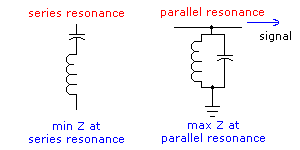What is resonance?
Resonance occurs when the reactance of an inductor balances the reactance of a capacitor at some given frequency. In such a resonant circuit where it is in series resonance, the current will be maximum and offering minimum impedance. In parallel resonant circuits the opposite is true.
Resonance formula
The formula for resonance is:
2 * pi * f * L = 1 / (2 * pi * f * C)
where: 2 * pi = 6.2832; f = frequency in hertz L = inductance in Henries and C = capacitance in Farads
Which leads us on to:
f = 1 / [2 * pi (sqrt LC)]
where: 2 * pi = 6.2832; f = frequency in hertz L = inductance in Henries and C = capacitance in Farads
A particularly simpler formula for radio frequencies (make sure you learn it) is:
LC = 25330.3 / f 2
where: f = frequency in Megahertz (Mhz) L = inductance in microhenries (uH) and C = capacitance in picofarads (pF)
Following on from that by using simple algebra we can determine:
LC = 25330.3 / f 2 and L = 25330.3 / f 2 C and C = 25330.3 / f 2 L
Impedance at Resonance
In a series resonant circuit the impedance is at its lowest for the resonant frequency whereas in a parallel resonant circuit the impedance is at its greatest for the resonant frequency. See figure 1.

Figure 1 - resonance in series and parallel circuits
"For a series circuit at resonance, frequencies becoming far removed from resonance see an ever increasing impedance. For a parallel circuit at resonance, frequencies becoming far removed from resonance see an ever decreasing impedance".
That was a profoundly important statement. Please read it several times to fully understand it.
A typical example to illustrate that statement are the numerous parallel circuits used in radio. Look at the parallel resonant circuit above. At resonance that circuit presents such a high impedance to the resonant circuit to the extent it is almost invisible and the signal passes by. As the circuit departs from its resonant frequency, up or down, it presents a lessening impedance and progressively allows other signals to leak to ground. At frequencies far removed from resonance, the parallel resonant circuit looks like a short path to ground. For series resonance the opposite is true.
Link to this page
NEW! - How to link directly to this page
Want to create a page link to me from your site? It couldn't be easier. No HTML knowledge required; even the technophobes can do it. All you need to do is copy and paste, the following code. All links are greatly appreciated; I sincerely thank you for your support.
Copy and paste the following code for a text link:
<a href="http://www.electronics-tutorials.com/basics/resonance.htm" target="_top">visit Ian Purdie VK2TIP's "Resonance" Page</a>
and it should appear like this:
visit Ian Purdie VK2TIP's "Resonance" Page

This site is hosted at WebWizards.Net for better value.
CARE TO BE A PRACTICAL SUPPORTER OF THIS SITE?
As you would imagine maintaining this site costs me considerable sums of money in many, many ways. If you believe this site is a valuable and FREE educational resource and, YOU want to keep it that way, then here's how YOU can demonstrate your very practical support for this site..
Thanks to these fine folks making voluntary donations, ensuring this site and our Newsletter remains FREE. Could YOU be listed here for your small contribution in return for your FREE education?. Our grateful thanks.


Please send me your valuable comments and suggestions! Tell your friends, tell a news group, tell your favourite magazine, heck tell the world!
Absolutely essential to keeping abreast of new and updated electronics tutorials is our comments or subscribe to our highly regarded FREE monthly newsletter form. Unsubscribe any time you like. You can view immediate past issues here to see if it is to your liking.
Related topics on resonance
capacitance
current
impedance
inductance
"Q"
reactance
voltage

YOU ARE HERE: HOME > BASICS > RESONANCE
the author Ian C. Purdie, VK2TIP of www.electronics-tutorials.com asserts the moral right to
be identified as the author of this web site and all contents herein. Copyright © 2000, all rights reserved. See copying and links.
These electronic tutorials are provided for individual private use and the author assumes no liability whatsoever for the application, use, misuse, of any of these projects or electronics tutorials that may result in the direct or indirect damage or loss that comes from these projects or tutorials. All materials are provided for free private and public use.
Commercial use prohibited without prior written permission from www.electronics-tutorials.com.
Copyright © 2000, all rights reserved. URL - www.electronics-tutorials.com/basics/resonance.htm
Updated 15th May, 2000
webmaster@electronics-tutorials.com


